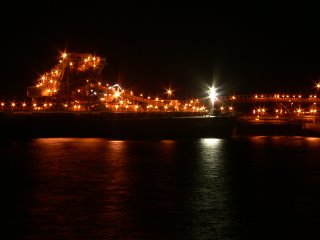Fowler’s Camp (Denham) 28 – 29 October 2006
Believe it or not, it rained last night at Gladstone – we were amazed, as it is the 4th time it has rained on our trip. There was a short thunder and lightning show across the water and minimal rain, though it kept up an occasional light shower through the night. Although there hadn’t been much rain, we were conscious of the threatening clouds and the bad track we had traversed to get to the camp, so we decided to pull up stumps to be sure, however it was fine and the clouds rolled on by with a rumble of thunder. We stopped at a nearby lookout that offered stunning views over Shark Bay and the dry coastal lakes of red soil. Next stop was Hamelin Pool to look at the stromatolites, which if we hadn’t known, we would have mistaken for rocks! You access the viewing over a board walk and when you look across them they are beautiful, distinct shapes. The biology of the micro-organisms was interesting, with the cyanobacteria being one of the first life forms (3,500 million years old) which raised the earth’s O2 to 20% all those millions of years ago. Thank you micro organisms! This was also the site of another Telegraph Station and the quarrying of shell blocks to make the local buildings. The whole area is comprised of tiny shells about 5 metres deep that have cemented together. The walk out to the stromatolites and quarry was blinding from the white shells. After lunch we went onto Shell Beach, which unsurprisingly is made up of billions of these minuscule Cockle Shells. It was marvellous to walk on the beach, crunch the shells, sit on the shells and drop them through you hands. The bay was shallow and we strolled out about 500m with water up to our ankles!
We then moved up the peninsula towards Denham and to Fowlers Camp, one of four recommended free camps before the dreaded caravan parks! This turned out to be one of the most beautiful spots so far, right on a large shallow bay, with stunning marine colours reflected in its calm waters. No one else came and we thought we owned paradise. It was so relaxing we decided to stay another day. In the morning we went for a long walk along the beach to the other side of the bay and found a few really wonderful shells. Unfortunately we also found a long dead Loggerhead turtle and although he had been dead a while, his beauty was still evident. He was covered in large white bleached barnacles whose lives were also cut short. In the afternoon we relaxed, had some fresh scones and went for a swim – heaven!!
How dare someone else turn up! We have neighbours over the back a bit. Hope they keep quiet or we will have to report them to the Paradise Police!















